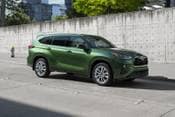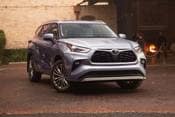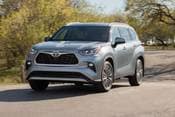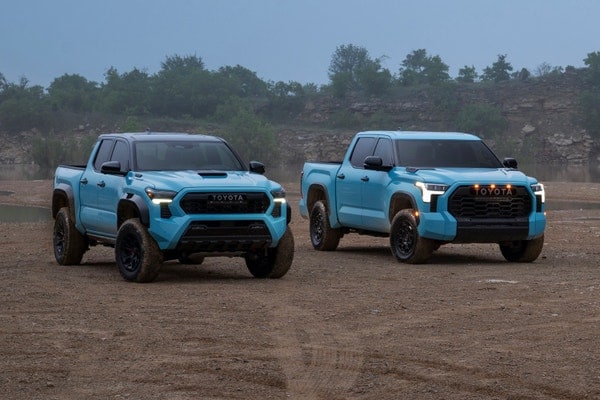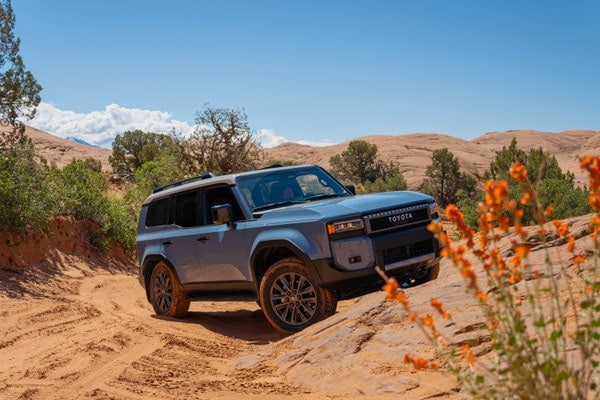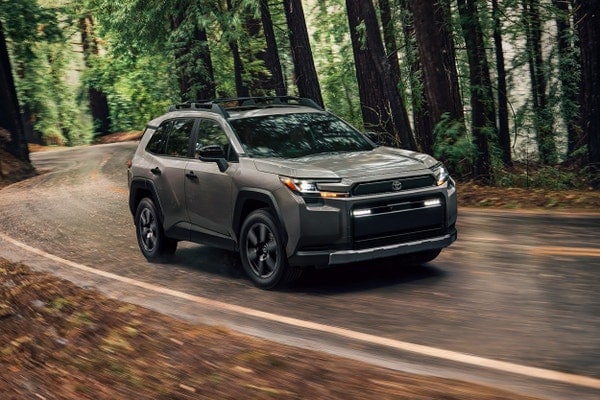The Toyota Highlander is a midsize three-row SUV with seating for up to eight passengers, and for 2023, it's offered in six trim levels: L, LE, XLE, XSE, Limited and Platinum. Midgrade trims and above swap the second-row bench for captain's chairs, reducing capacity to seven passengers. All models are powered by a turbocharged 2.4-liter engine that produces 265 horsepower and 309 lb-ft of torque, and it's mated to an eight-speed automatic transmission that drives the front wheels. All-wheel-drive is available on all trims as an option. There's also a Highlander Hybrid that we review separately on Edmunds.
Note that some of the Highlander's extra features on the upper trims are offered on supporting trims as options.
L
The base L is well equipped and comes with:
- 18-inch alloy wheels
- LED headlights
- Heated mirrors
- Keyless entry and ignition
- Power-adjustable driver's seat
- Tri-zone automatic climate control
- Second- and third-row 60/40-split folding seats
- 8-inch infotainment touchscreen
- 7-inch digital instrument panel display
- Wireless connectivity for Apple CarPlay and Android Auto
- Amazon Alexa smartphone integration
- Onboard Wi-Fi hotspot
- Four USB-C charging ports, one USB-A media port
- Emergency communications (Toyota's Safety Connect)
- Toyota's Safety Sense 2.5+ suite of advanced safety features:
- Frontal collision mitigation (warns you of an impending collision and applies the brakes in certain scenarios)
- Adaptive cruise control (adjusts speed to maintain a constant distance between the vehicle and the car in front)
- Automatic high beams
- Lane keeping system (makes minor steering corrections to help keep the vehicle centered in its lane)
- Traffic sign reader
LE
The LE trim adds a handful of convenience and safety features such as:
- LED foglights
- Height-adjustable power liftgate
- Leather-wrapped steering wheel and shift knob
- Blind-spot warning with rear cross-traffic warning (alerts you if a vehicle is in your blind spot during a lane change or while in reverse)
XLE
The seven-passenger XLE upgrades the Highlander with:
- Roof rails
- Sunroof
- Wireless charging pad
- Auto-dimming rearview mirror
- Simulated leather upholstery (SofTex)
- Heated front seats
- Power-adjustable passenger seat
- Second-row captain's chairs
- Second-row sunshades
There are a couple of options for the XLE:
- Second-row bench seat (no-cost option)
- Navigation system
XSE
The XSE trim represents the sporty choice in the lineup. It builds off the XLE model and adds:
- 20-inch wheels
- Unique sporty styling cues
- Sport suspension
- Chrome exterior trim
- Dual exhaust tips
- Interior ambient lighting
Leather upholstery and the larger 12.3-inch center touchscreen are optional.
Limited
Stepping up to the Limited trim adds plenty of luxury items that include:
- Upgraded foglights
- Hands-free liftgate
- Leather upholstery
- Ventilated front seats
- Memory functions for the driver's seat
- Heated steering wheel
- Household power outlet
- 12.3-inch multimedia touchscreen
- Intercom system that broadcasts the driver's voice through the speakers
- 11-speaker JBL audio system
- Front and rear parking sensors (alert you to obstacles that may not be visible in front of or behind the vehicle when parking)
A second-row bench is also optional for the Limited as a no-cost option.
Platinum
At the top of the range, the Platinum includes everything above, plus:
- 20-inch alloy wheels
- Adaptive headlights (swivel as you turn the steering wheel for better illumination in curves)
- Automatic wipers
- Panoramic sunroof
- Head-up display (displays important information in your sight line onto the windshield)
- Digital rearview mirror (allows you to see out the back even with a fully loaded cargo area)
- Heated second-row seats
- Surround-view camera


